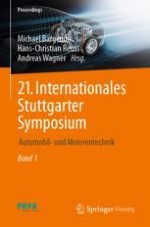2021 | OriginalPaper | Buchkapitel
New Solution Supporting Efficient Vehicle Calibration Using Objective Driveability Evaluation and AI
verfasst von : Xianfeng Zhang, Thomas Ebner, Martin Arntz, Andreas Ramsauer, Ferit Küçükay
Erschienen in: 21. Internationales Stuttgarter Symposium
Verlag: Springer Fachmedien Wiesbaden
Aktivieren Sie unsere intelligente Suche, um passende Fachinhalte oder Patente zu finden.
Wählen Sie Textabschnitte aus um mit Künstlicher Intelligenz passenden Patente zu finden. powered by
Markieren Sie Textabschnitte, um KI-gestützt weitere passende Inhalte zu finden. powered by
